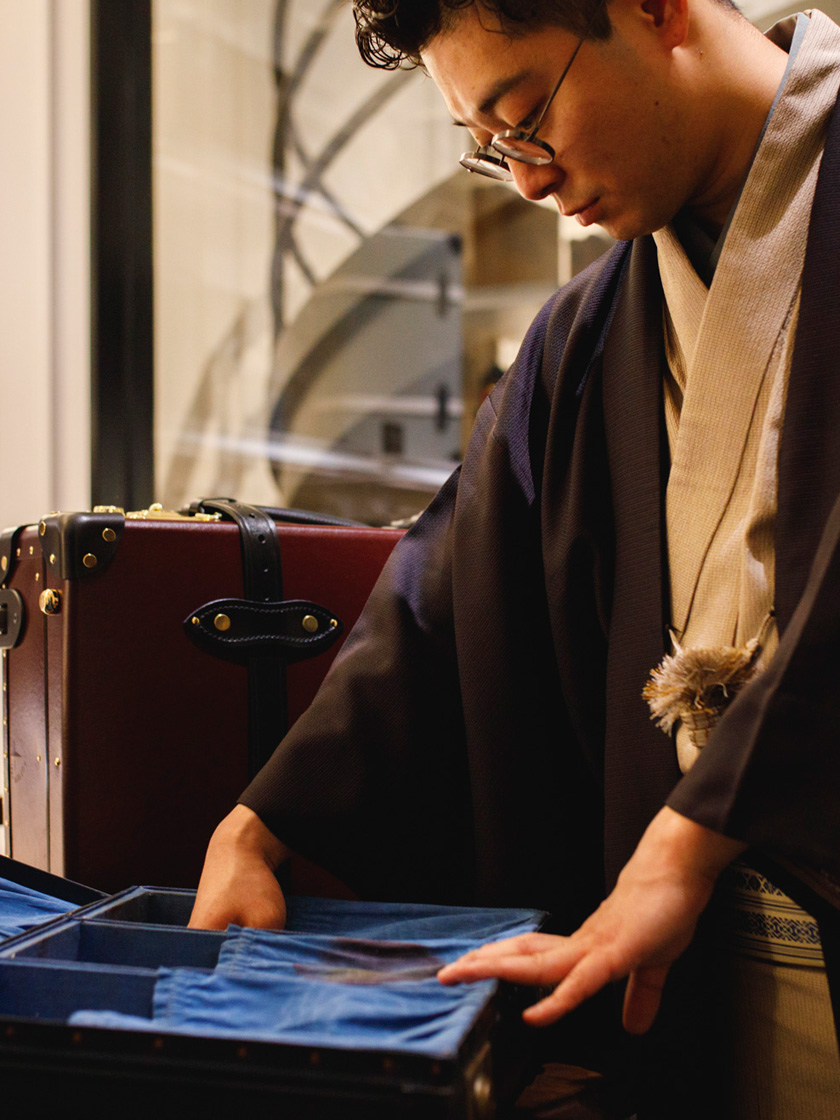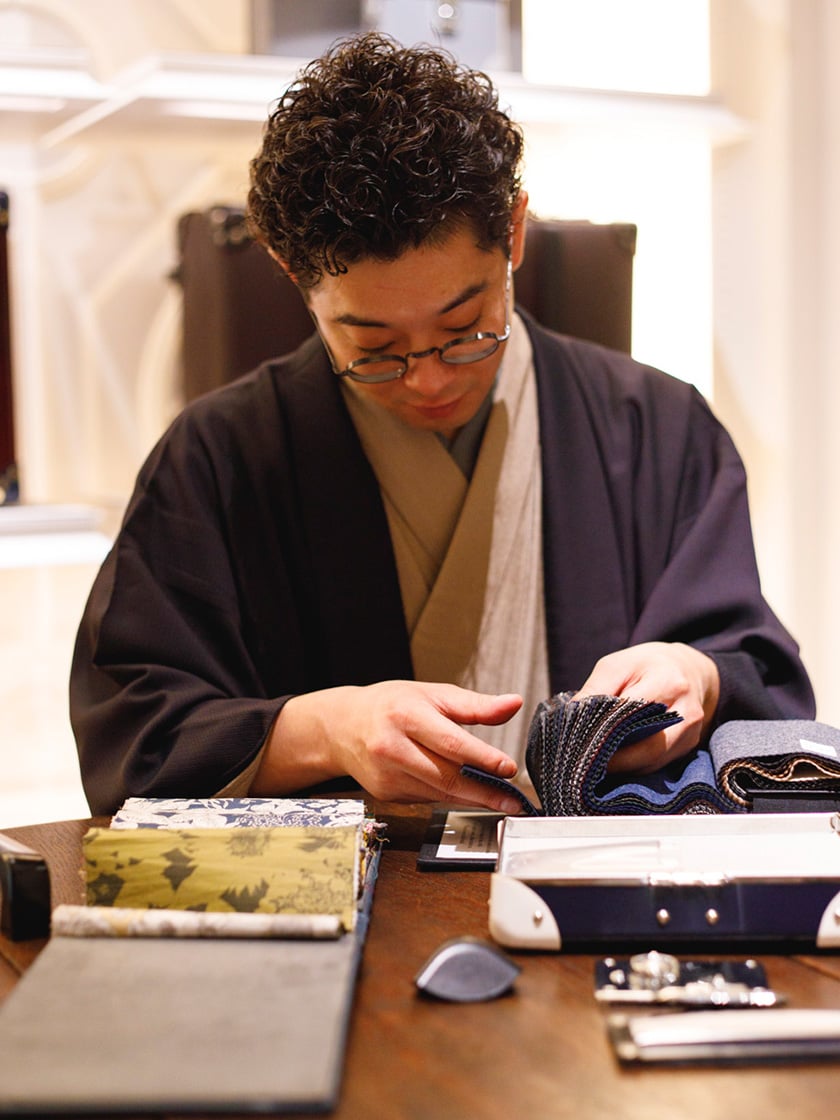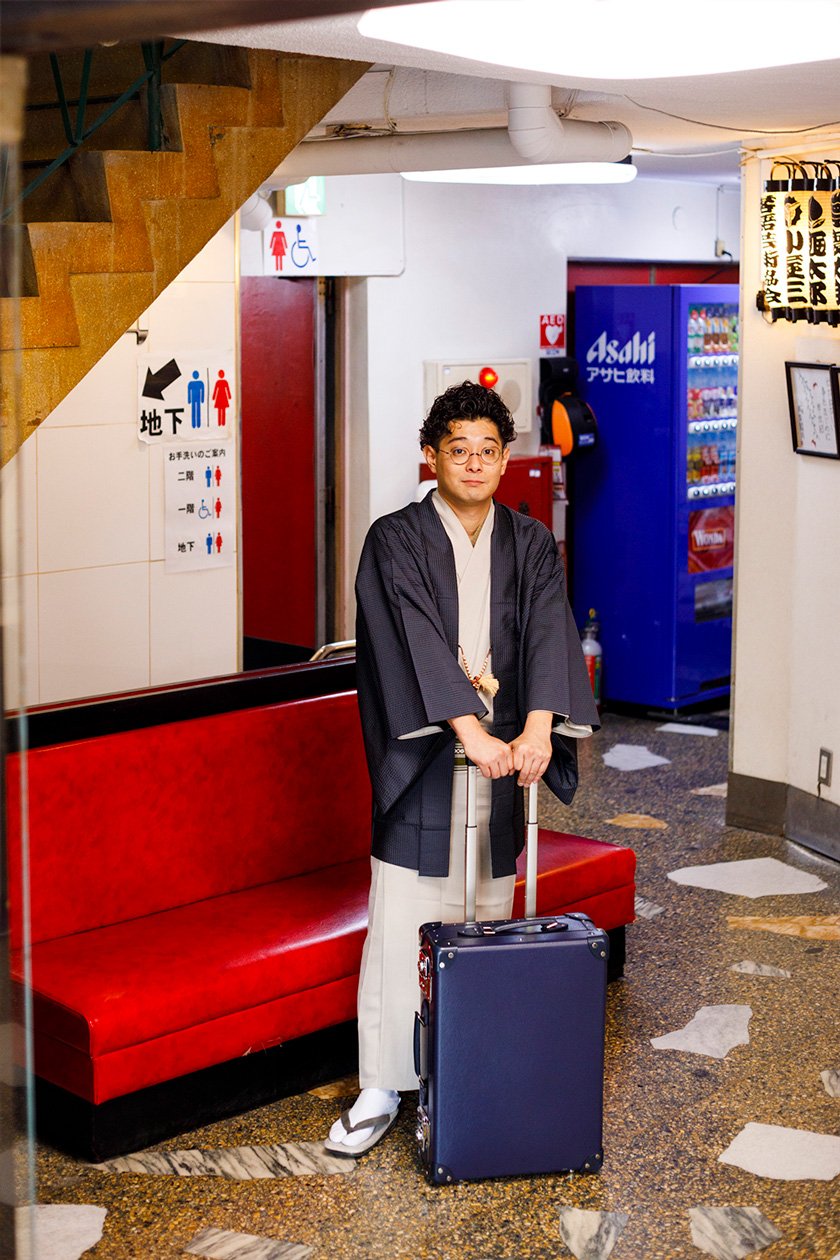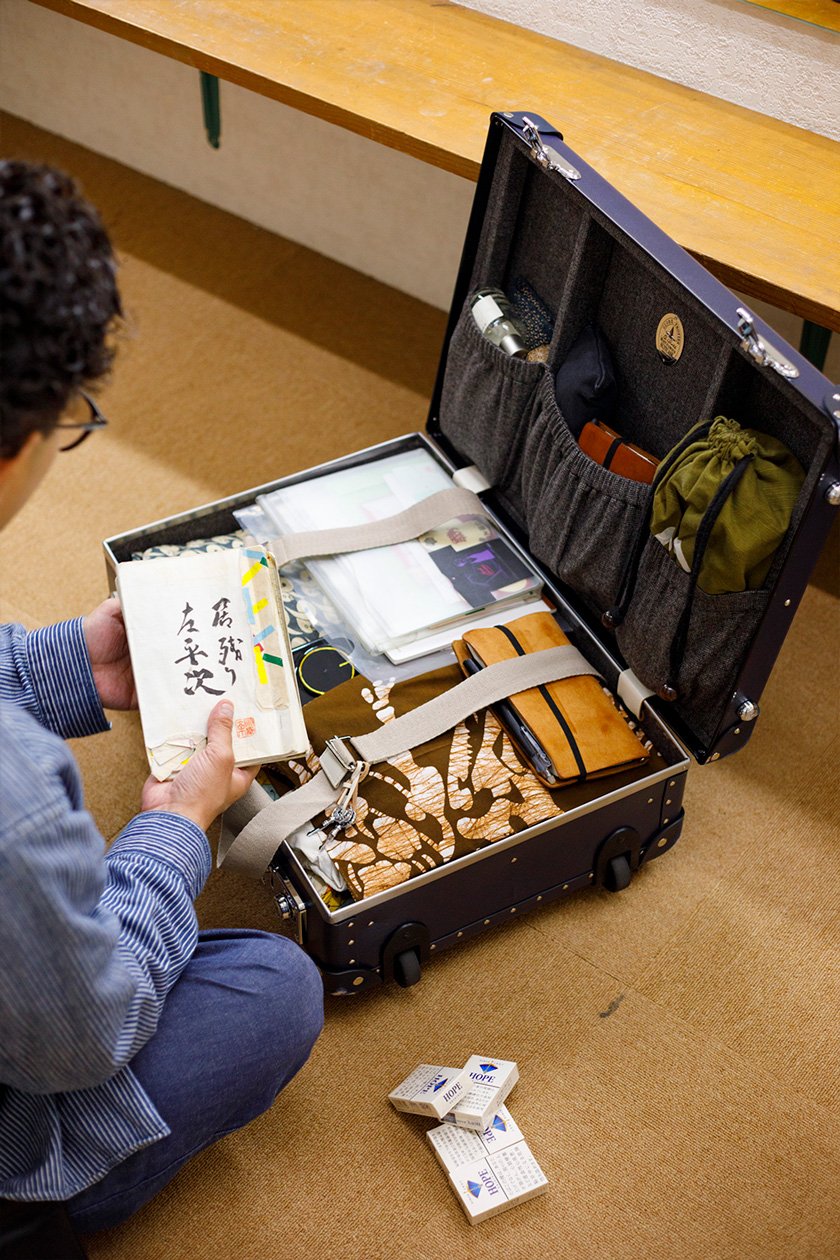Bespoke for Professionals With Rakugo Storyteller Ryu-Tei Kochiraku.
Ryu-Tei Kochiraku performs at Tokyo’s Asakusa Engei Hall and other traditional Yose comedy theatres dedicated to the art of storytelling throughout Japan. He is very particular about his possessions, even tailoring his own suits as well as his kimonos. This is the first time he has had his luggage tailor-made by Globe-Trotter’s Bespoke service. The inside is intricate, while the outside looks "like a bag held by Tora-san" (Japan’s much-loved travelling salesman character from a highly-popular film series which first screened in 1969), who was always on the move with his pared-back suitcase. The result; a simple partner that he can use for many years to come.

'This one's good, but this one's good too. It's a difficult decision to make...’
How to make the best design by balancing your own desires with other’s suggestions.
The Bespoke service at Globe-Trotter Ginza allows you to create your own original travel case. You can order your one-of-a-kind luggage from tens of thousands of options, with everything from the exterior of the suitcase body, corners and hardware, to the interior lining and stitching, according to your preference. Our experienced staff at the Ginza shop can help you realise your vision through their close attention to detail and careful explanations.
For this project, Mr Kochiraku wanted to be able to neatly store his unique rakugo (the Japanese art of story-telling) belongings, such as his traditional slippers and kimono. The first step in the bespoke process is for the staff to understand his travel needs.
'I use it mainly when I go away for solo performances. I often return to Tokyo after work, so it's usually one or two nights that I’m away. So I would be happy if I could fit two kimonos, a pair of slippers, some underwear, a pencil case, a contact lens case, a Ryukakusan (Japanese herbal lozenges) pouch, books, etc.". Up until now, he used a suitcase with wheels or a rucksack. “I always used a quick and easy carry-on bag so I wouldn’t keep my master waiting," he adds, referencing his rakugo background.

The Bespoke service takes place in a dedicated space at the back of the flagship store. First, the customer is consulted about the size of luggage they are after, and shown various samples. Mr Fumitoshi Sano is the consultant in charge of the Bespoke service.

They go around the shop, looking for the right size case. The carry-on suitcase is ideal for short trips or business trips between one to three nights and is permitted as carry-on baggage on many airlines.

To check if it is the correct size he’s after, they fill it with some of his belongings. They decide on the carry-on size (W42 x H56 x D21 cm) which fits two kimonos comfortably.
One of Mr Kochiraku’s most desired features is a bespoke shoe case for his traditional leather-soled slippers, known as setta, which are an essential part of a rakugo artist's attire. Mr Sano brings out a vintage Globe-Trotter to show him. 'This is a model from the 1930s, made specially for ballet shoes. It has a wooden box inside to hold the shoes. It's also a very old model, so we have to consult with the factory in England, the brand's home country, to see if we can actually do it," says Mr. Sano. It is only through a Bespoke consultation that such details can be discussed at this level.


Examining the storage space needed for his traditional slippers or setta, and comparing the 1930s shoe case made for ballet shoes. Taking Mr. Sano's advice, a storage slot for the slippers can be created on the lid.
A conundrum encountered during the Bespoke process was the luggage wheels. That is, whether he should choose two wheels or four wheels? Mr Kochiraku is firmly in favour of four wheels. He says: "I'm used to using them, and I find that two wheeled cases are difficult to move”. However, Mr Sano recommends two wheels on this occasion. “Globe-Trotter’s 4-wheeled cases have wheels built in on the inside, rather than the outside. This design is slick and is easy to use. But with the two wheeled design you have more freedom designing the layout on the inside, because the trolley system is mounted on the outside of the suitcase. It's also a lot easier to pack”. Mr Kochiraku looks at the luggage again, and realises at first glance the wheels appear very inconspicuous. 'Great… you’ve convinced me to go with two wheels!' and he laughs.


The two-wheeled carry-on can be tilted at an angle for greater mobility. Fabrics for the inside of the luggage can be selected. There are approximately 100 different options to choose from.
'I want my case to continue to look great, even when it's battered and I'm an old man carrying it,' says Mr Kochiraku. He decides to keep it simple and take off the leather straps that secure the outside. Mr Sano offers the following advice on the colour. “The navy colour will develop a beautiful blue gradation when it ages", he says. After looking at the leather samples of the eight corners and handles, he also settles on navy, the same colour as the vulcanized fibreboard body. “I'm sorry my colour choices are not bold” and he laughs.
The ground work for the suitcase design is slowly coming together: the size, choice of wheels, the colour of the exterior. “However," says Mr Sano, "there are still half a dozen things that we still need you to decide on. The final thing to consider is the interior of the case”. The fabric for the paper-backed lining on the inside, can be selected from a large number of swatches. Mr Kochiraku decides on a flannel fabric called 'Papitooth' from FOX BROTHERS, a British company which has been around for more than 250 years. The same fabric is used for the shoe case for his setta slippers. Furthermore, the inner webbing belts for organising belongings and the leather hinges at the back of the suitcase attaching the lid and the base are in a matching beige colour, similar to the fabric. Finally, the order is complete after a mockup of the design is presented to Mr Kochiraku.

Using his wealth of knowledge from handling numerous bespoke orders, Mr Sano writes the details of the order on a sheet and compiles them. Suited for Western as well as Japanese outfits. With its chic appearance, this luggage fits perfectly into the rakugo universe.


At a performance at the Asakusa Engei Hall with his Globe-Trotter. It has only been in use for about a week and it’s condition is still as good as new.
Six months after the order was placed, the finished product was finally delivered to Mr Kochiraku. 'I packed it straight away. My two sets of kimonos and, of course, the setta slippers fit perfectly". When asked to show the contents of his luggage, he told us that he had also managed to fit in a pen case, a novel, contacts, glasses, wallet and other small items.
The capacity is more than meets the eye. The right pocket holds the tradtional Japanese setta slippers perfectly.
We asked him how he felt about choosing the two-wheeled version after much deliberation. 'It's very easy to use. I was worried that the corners would get damaged, but I'm relieved to say there is little damage, and if they do get damaged, they can be replaced. I'm glad I took Mr Sano’s advice’.

Mr Kochiraku on his way to the Yose theatre.

Getting around with the case with two wheels. The wheels appear hidden, giving it a clean silhouette.
Mr Kochiraku is very familiar with the area when he performs on stage at the Asakusa Engei Hall. ‘I enjoy eating curry soba (buckwheat noodles) at O-Soba. The cold tanuki (buckwheat noodles with fried tempura batter crumbs) is also delicious. I've been going to Yoshikami restaurant since I was a child. I regularly have the pork sauté’.

After changing into his rakugo attire, it's time to go on stage. The slightly ajar case appears at home in his changing room.
After changing into his kimono, it's time to get going. The luggage looks as good alongside a kimono as it does next to western clothes. ‘I want it to have a weathered look, so that it becomes immediately recognisable. I'll even go as far as checking it in on international flights, if I have the chance. I want it to pick up scuffs!’ he laughs.

Performing to a packed audience at Asakusa Engei Hall. His luggage awaits him in the dressing room.
Newsletter Signup
Sign up for our exclusive newsletter to unlock insider access, travel inspiration, VIP events, and expert tips.






